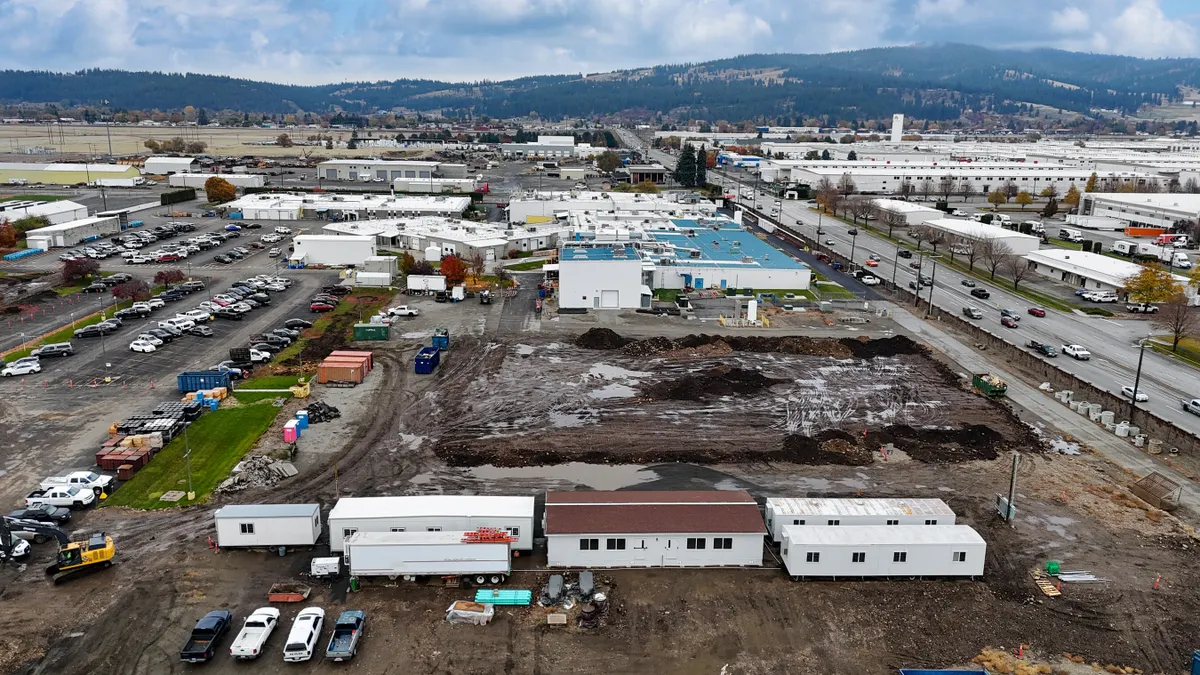Signs point to decreased construction activity in coming months as financing costs for many developers have become prohibitively high, sources told Construction Dive.
For example, increased interest rates are making construction projects more risky and less profitable, said Nicolas McNamara, director of project management at CBRE, a Dallas-based commercial real estate services firm.

“Increased financing costs remain a concern around construction.” said McNamara. “Developers are challenged with projects that simply are not penciling due to increased rates.”
Recent uncertainty in the banking industry is compounding that issue for construction firms, he said.
The impacts of those headwinds are already visible. Construction backlog decreased to 8.7 months in March, its lowest level since August 2022, according to Associated Builders and Contractors.
Meanwhile, the Dodge Momentum Index, a benchmark that measures nonresidential building planning, tumbled 8.6% in March, a fall that Sarah Martin, Dodge’s associate director of forecasting, tied to banking insecurity.
“Lending standards for small banks in particular have substantially tightened as banking insecurity intensifies,” said Martin. “As a result, owners and developers are more likely to pull back in the short term.”
This uncertainty will cause big banks to either be cautious in lending or to mitigate risk with higher rates, said Todd Burns, president of project and development services at Chicago-based JLL, a real estate services company. These large banks, such as JP Morgan, Citi and Morgan Stanley, tend to set the market price for the cost of capital.

“The increased interest rates and the cost of capital will continue to influence financing negatively,” said Burns. “If the cost of capital is high, then financing will obviously be high as well.”
That trend is fueling increased concerns about access to capital in general, and the development of a vicious cycle where lenders charge more to limit their risk, and developers won’t or can’t pay higher interest rates to achieve their targeted returns. The result could trigger a long-talked about recession, said McNamara.
“Banks do face asset issues, such as unhedged exposure to government securities and exposure to falling real estate values,” said McNamara. “The current situation could lead to tighter credit conditions and the possibility of a moderate recession in the second half of 2023.”
Focus on yield
Another factor influencing financing availability is the focus on yield, said McNamara. Developers are now required to achieve higher unlevered yield on cost — a property’s return after purchasing costs and renovation expenses — to move forward with projects due to this changing financing landscape.
This creates challenges for new projects to meet their financial goals and may lead to fewer projects being approved, he added. McNamara said to expect “seeing projects getting canceled entirely or significantly phased or cut back to be able to be financed.”
At the same time, owners and developers are showing a willingness to wait out these interest rate fluctuations, which further slows down building starts, said Burns. When projects do pencil out in the current environment, it’s only after considerable diligence.
That delay ultimately leads to more costs, said McNamara.
“If they are penciling, it’s after a significant round of time and preparation has happened,” said McNamara. “Then additional escalation is required for rising construction costs.”
For instance, Shopoff Realty Investments paused construction on its approximately $550 million Las Vegas Dream Resort due to construction financing issues, according to Bill Shopoff, its president and CEO, in an email to Construction Dive.
High interest rates and unfavorable capital markets also pushed Vornado to delay its Penn Station project for another two to three years, according to Michael Franco, its president and CFO, during the company’s most recent earnings call in February.
“Capital markets are now making it almost impossible to build new,” Franco said.
Long lead times
Long lead times for materials since the start of the COVID-19 pandemic are compounding these lending challenges.
“Longer lead times increase the cost to carry the goods for contractors and developers,” Burns said.
Lead times remain at “unprecedented levels,” especially for critical mechanical and electrical equipment, said Richard Kennedy, president and CEO of Skanska USA. Although some materials have become more readily available, the overall supply chain still remains in a fragile state, according to a first quarter CBRE market trends report.
For instance, Harrington Industrial Plastics, a Chino, California-based supplier, reported experiencing supply issues for all materials, according to a recent report from XL Construction. Meanwhile, Ryan Herco Flow Solutions, a Burbank, California-based supplier, recently ran out of one type of piping supply, resulting in additional delays, according to the XL Construction report.
That, in turn, only inflates the actual cost of capital even more.
Long lead times still pose challenges for contractors
| Material | Anticipated lead time |
|---|---|
| Polypropylene piping | 12 months |
| MEP equipment | 16-35 weeks |
| Fabricated structural steel | 20-24 weeks |
| Metal bar joists | 18-24 weeks |
| Plumbing fixtures | 16-20 weeks |
| Drywall | 4-16 weeks |
| Concrete | 10 weeks |
| Reinforcement bars | 8 weeks |
| Steel piping | 6-8 weeks |
| Insulation | 4 weeks |
| Lumber | 2 weeks |
SOURCE: XL Construction
“That cost has to be covered by financiers,” said Burns. “This could potentially lead to banks continuing to charge high rates for cash thus prolonging economic headwinds.”
Nevertheless, the Federal Reserve’s liquidity support during the Silicon Valley and Signature Bank failures, and the implied guarantee of uninsured deposits at other banks could begin to stabilize the situation, said McNamara. The International Monetary Fund also said April 11 that bank failures last month may cause a credit squeeze that bolsters central bank efforts to curb price pressures.
In addition, many observers think the banking failures could ultimately force the Federal Reserve to put the brakes on interest rate hikes. In March, it raised rates a quarter percentage point but indicated the increases could come to an end.
McNamara added the industry likely is not facing a crisis like 2008, though admits it is “too early to be certain.” That’s because although the regional bank failures in the U.S. were significant, international contagion remains limited.
“The silver lining is that it may help the Fed restrain a buoyant private sector and combat inflation. Interest rate rises are still expected, but moderate rate cuts could begin in the fourth quarter,” said McNamara. “A moderate downturn is more likely than a hard landing, given stronger consumer and business balance sheets, the absence of a major construction boom and a healthier international economy compared to 2008.”























